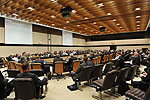Armaments directors address current and future challenges
On 15 October, armaments directors from NATO states and 12 Partner countries met at the Alliance’s headquarters in Brussels for the biannual Conference of National Armaments Directors (CNAD).

They focused on developing key capabilities for addressing 21st century threats to international security, including terrorism and piracy. The meeting’s underlying themes were the potential impact of the new Strategic Concept for the Alliance, the transformation of the CNAD structures and procedures, and the effects of the ongoing economic crisis.
Peter Flory, NATO Assistant Secretary General for Defence Investments, told armaments directors that the key solution to these issues lies in improving cooperation and interoperability, and decreasing duplication. The Alliance needs not only to build “capabilities for today’s needs, but also to prepare for tomorrow’s challenges”, he said.
Key achievements
 During the conference, participants discussed a way forward for the Defence Against Terrorism Programme of Work (DAT PoW). Richard Froh, NATO's Deputy Assistant Secretary General for Armaments and its Counter Terrorism Technology Co-ordinator, outlined the progress achieved so far in developing and deploying practical measures to mitigate terrorist attacks.
During the conference, participants discussed a way forward for the Defence Against Terrorism Programme of Work (DAT PoW). Richard Froh, NATO's Deputy Assistant Secretary General for Armaments and its Counter Terrorism Technology Co-ordinator, outlined the progress achieved so far in developing and deploying practical measures to mitigate terrorist attacks.
To better support Operation Ocean Shield, the Alliance’s ongoing anti-piracy mission off the Horn of Africa, armaments directors launched an initiative to help further develop nations’ capabilities for countering the growing threat of pirates.
To enhance Allied forces’ ability to face new challenges, participants discussed how they could help nations operating the Austrian Pandur wheeled armoured personnel carrier, either by developing new capabilities or creating a user group.
They also noted the milestone reached in September with the signing of the memorandum of understanding for the Allied Ground Surveillance (AGS) programme, which describes the programme’s legal, organisational and budgetary framework.
Technology vital for tomorrow’s challenges
The conference provided an opportunity to brief armaments directors on a new approach for developing research and technology priorities for NATO, to ensure that the Alliance maintains a technological edge and has the means to respond rapidly to new challenges.
And finally, issues related to multinational approaches to armaments cooperation were examined, with a special focus on Afghanistan and the need for more helicopters, both for Allies and their partners.
.
